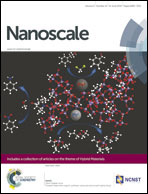Formation and photovoltaic performance of few-layered graphene-decorated TiO2 nanocrystals used in dye-sensitized solar cells
Abstract
Few-layer graphene/TiO2 nanocrystal composites are successfully in situ synthesized at a low temperature of 400 °C using C28H16Br2 as the precursor. Raman mapping images show that the TiO2 nanocrystals are very uniformly dispersed in the composite films, and the in situ coating during the thermal decomposition process will favor the formation of a good interface combination between the few-layered graphene and the TiO2 nanocrystals. The few-layer graphene/TiO2 nanocrystal composites are used as photoanodes in dye-sensitized solar cells (DSSCs), and the conversion efficiency of 8.25% is obtained under full sun irradiation (AM 1.5), which increases by 65% compared with that of the pure TiO2 nanocrystal DSSCs (5.01%). It is found that the good interface combination between few-layered graphene and TiO2 nanocrystals may improve the electric conductivity and lifetime of photoinduced electrons in DSSCs. Moreover, some carbon atoms are doped into the crystal structure of the TiO2 nanocrystals during the thermal decomposition process, which will enhance the light absorption by narrowing the band gap and favor the improvement of the photovoltaic efficiency.


 Please wait while we load your content...
Please wait while we load your content...